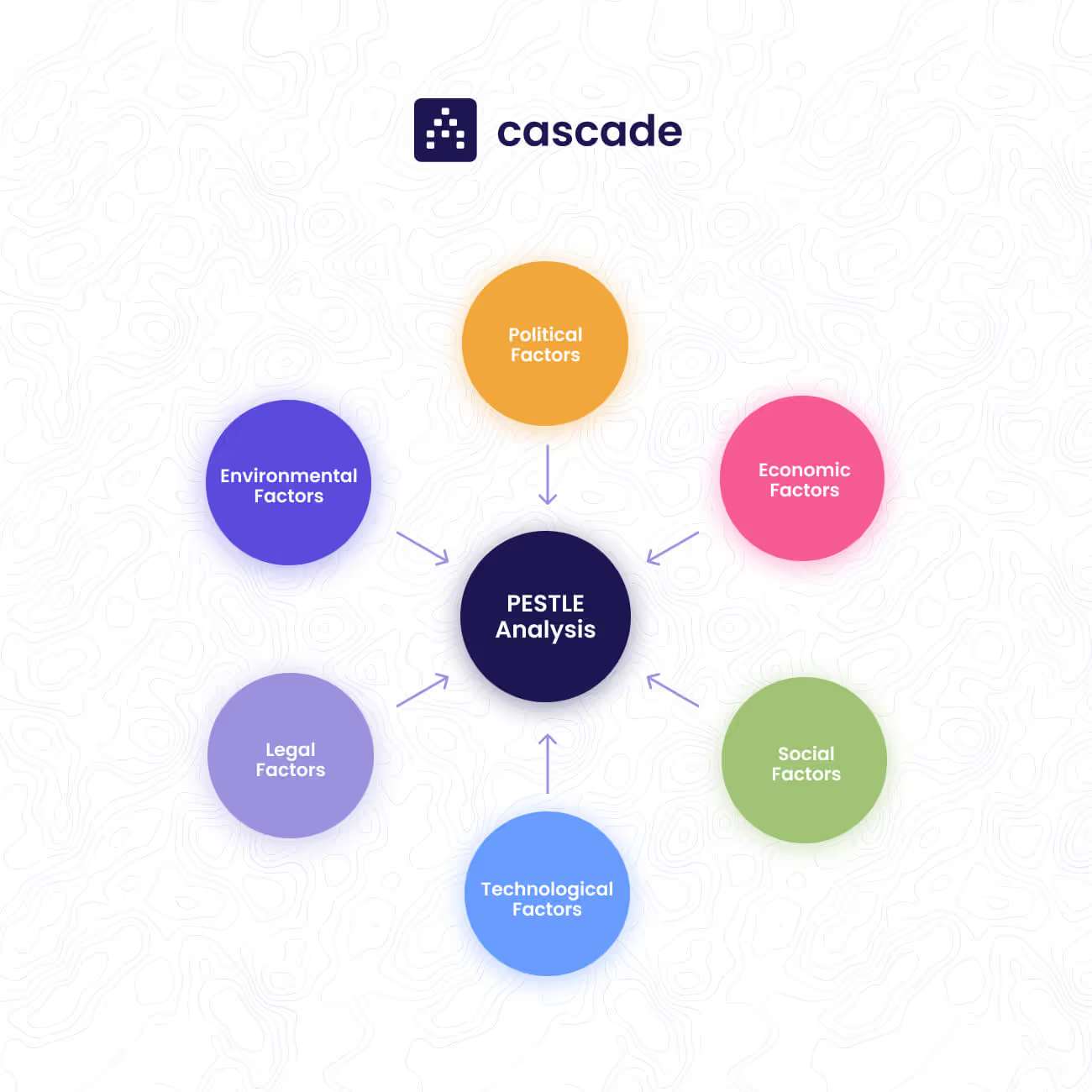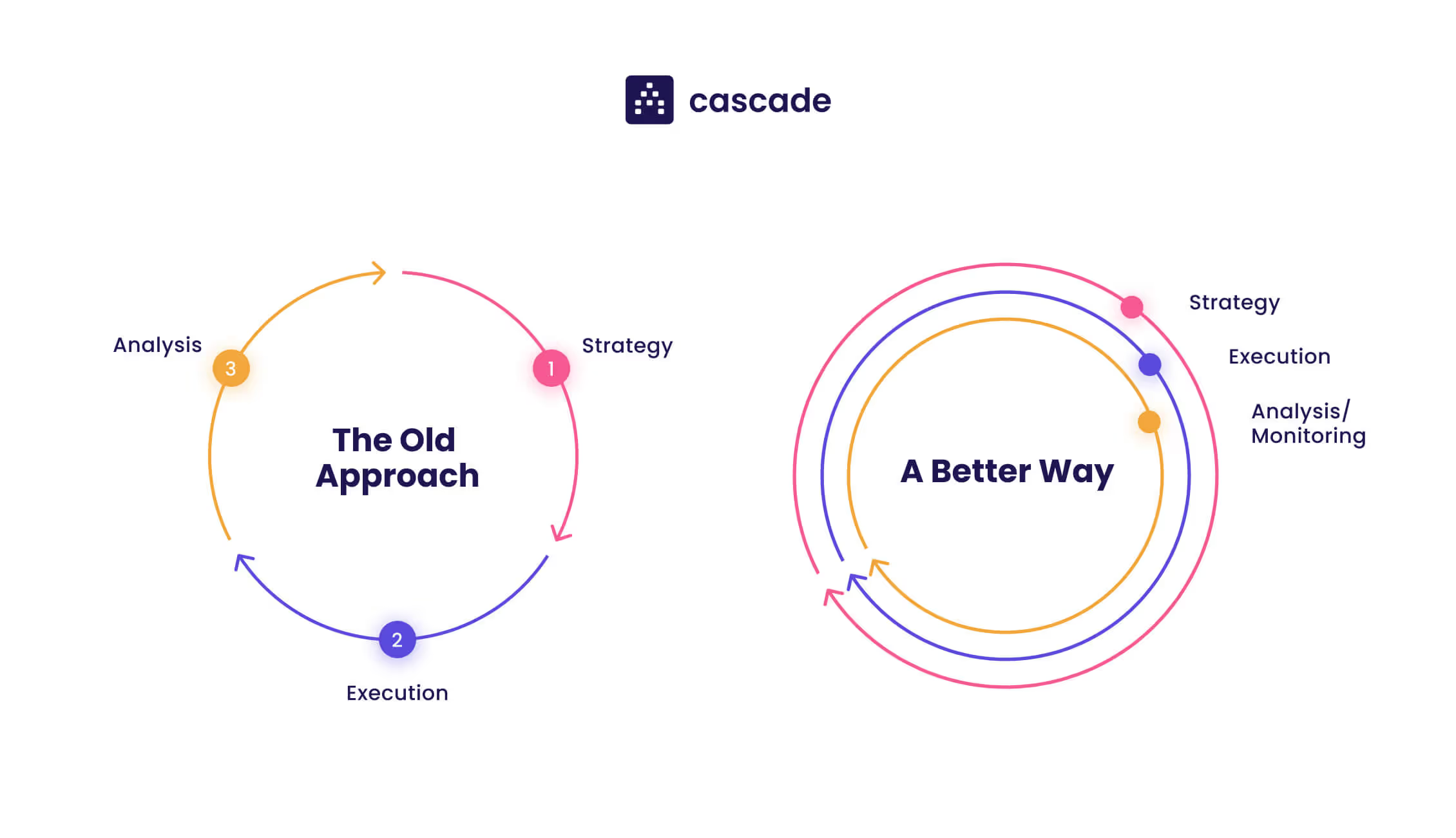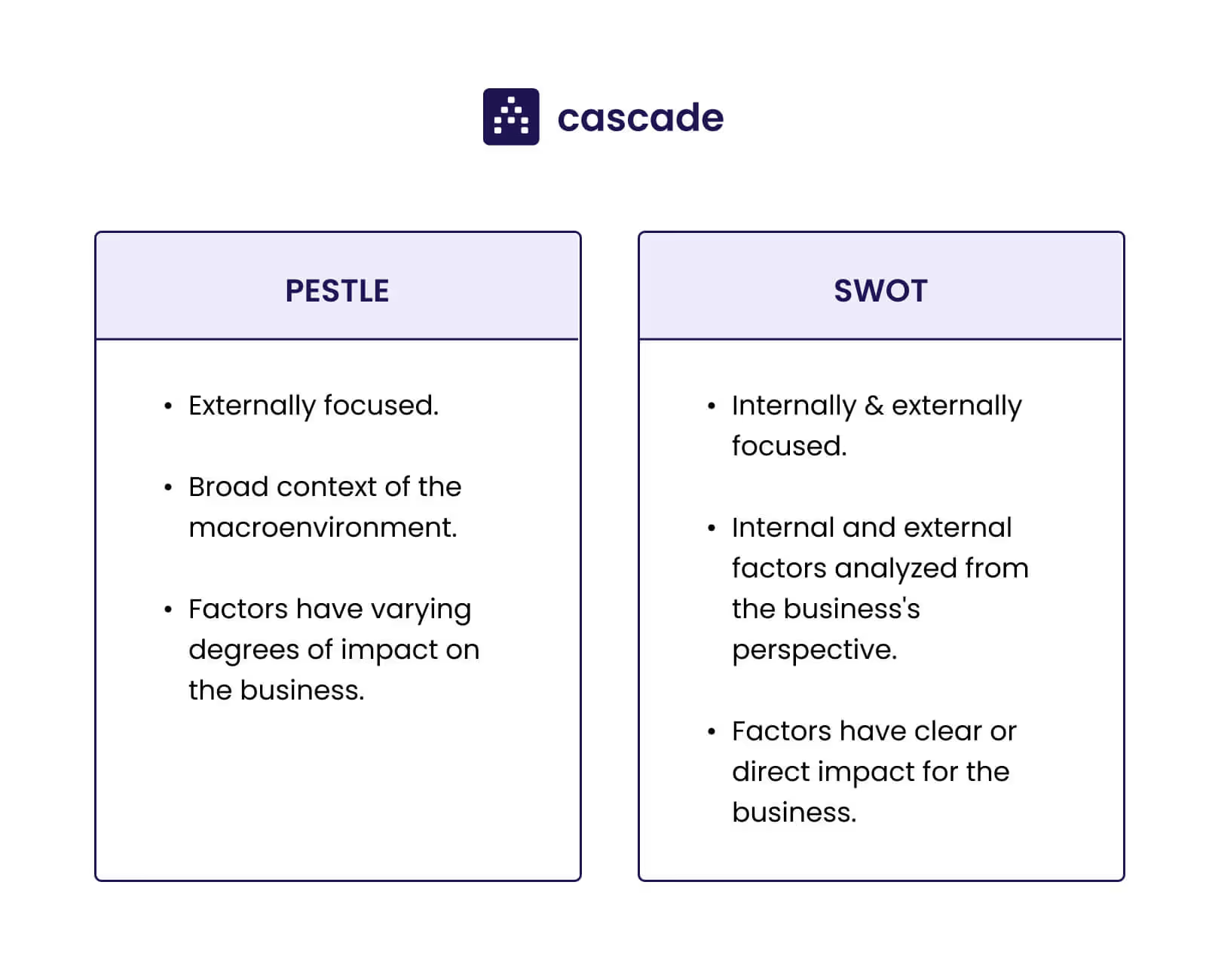A PESTLE analysis is a tried-and-true approach for identifying macro-environmental factors that might impact an organization.
This type of assessment can help teams with strategic decision-making, business analyses, and navigating periods of change.
But, if you’re doing strategic planning for a large organization, division, or multiple SBUs, performing a PESTLE analysis quickly, accurately, and consistently can be challenging to get right.
This article will cover everything you need to know to complete a PESTLE analysis for your organization, including when you should do it, and how to combine it with other strategic frameworks.
As a bonus, you can access your free Google Sheet PESTLE analysis template to streamline your process and quickly determine which external factors require immediate attention.
TL;DR
- PESTLE, PESTEL or PEST analysis is a strategic framework used to identify macroenvironmental influences on an organization of a business.
- The PESTLE framework divides external influences into six sections: Political, Economic, Social, Technological, Legal, and Environmental.
- Pros: PESTLE is simple to understand and use, making it a good framework for businesses of all sizes.
- Cons: The validity of PESTLE assessment largely depends on the quality and amount of information available to an organization.
⚠️ Go beyond the forecast! Understanding external factors is crucial, but strategic advantage comes from action. Cascade Strategy Execution Platform bridges the gap between analysis and execution. Talk to our experts to transform your PESTLE insights into an actionable plan for navigating change and seizing opportunities.
When Should You Do a PESTLE Analysis?
While it may not be needed for all strategy-related activities, every company has multiple use cases for PESTLE analyses. Here are a few common examples:
- Strategic planning: PESTLE is a useful starting point for most strategic decision-makers and it can help lay the groundwork for more in-depth research.
- Reviewing market position: Companies can use PESTLE to better understand shifts in market position over time and contextualize organizational growth, decline, or stagnation.
- Marketing planning: PESTLE can offer marketing teams valuable insights into external factors that impact marketing, PR, and advertising projects.
- Product development: PESTLE is helpful for understanding consumer sentiment from various angles and can assist organizations that want to know how products should be designed, changed, or marketed.
- Organizational change: Whether an organization is changing direction, restructuring, or expanding, a PESTLE analysis, combined with other strategic frameworks, can provide valuable information about external factors that will impact transformation initiatives.
What Are the 6 Elements Of PESTLE?

A PESTLE or PESTEL analysis divides macroenvironmental elements into six categories, each of which can impact an organization differently. Here are the six PESTLE factors:
Political factors
Political factors relate to the political interactions between governments, countries, and various political actors.
For example:
- Diplomatic relations between countries
- Political stability and continuity
- How governments operate
- The prevalence of civil society
- The potential for political unrest
- Foreign trade policies
Economic factors
These encompass the key economic elements within the business environment that can impact your organization.
For example:
- Exchange rates
- Inflation
- Interest rates
- Economic growth rates
- Corporate taxation rates
- Unemployment rates
Social factors
Social factors or sociocultural factors define group consumer behavior and thinking. They can include quantitative, such as average age, and qualitative data, such as opinions.
For example:
- Demographics
- Education levels
- Social views
- Age distribution
- Disposable income
- Cultural stability
Technological factors
Technological factors are tech-related developments, shifts, and patterns that could directly or indirectly impact your business. This can include broader global or regional conditions.
For example:
- Internet connectivity
- Specific technologies, like automation
- Advancements in your industry
- Intellectual property
- Rate of technological change
- Research and development lifecycles
Legal factors
Legal factors are current laws, regulations, and bills that may affect the organization’s operations and future plans.
For example:
- Competitive regulations
- Health and safety regulations
- Government policy
- Tax policies
- Antitrust laws
- Import/export laws
Environmental factors
Environmental or ecological factors look at the impact of businesses on the environment and how the environment might affect the business.
For example:
- Natural disasters
- Weather patterns
- Consumer health
- Climate change
- Resource availability
How Do You Do a PESTLE Analysis Step By Step?
While there is no clearly defined way of doing a PESTLE analysis from start to finish, a systematic planning process and approach can increase efficiency and impact.
Here are six steps to do a PESTLE analysis the right way.
1. Prepare for your analysis
Before you begin, lay the groundwork to ensure accuracy, quality, and focus. The saying “measure twice, cut once” will pay dividends down the line.
Create a founding document that answers these questions:
- Why — The reason you’re conducting a PESTLE analysis.
- What — The scope, goals, and initiatives.
- Who — The key people needed in the analysis process.
- Where — Where are we going to look for information?
- When — The deadlines for the data and final insights.
Answering these questions will explain how to approach your PESTLE analysis.
Finally, organize a meeting with involved team members and stakeholders to present the plan, communicate success metrics, and get feedback.
2. Collect data for your PESTLE analysis
Gather the information you need to fill out your PESTLE diagram. This may require primary research and consultation with external industry experts. You will likely need various types of data and information.
But don’t get bogged down in data and research. A PESTLE analysis is meant to speed up traditional research by focusing your efforts.
To streamline the process, concentrate on one area at a time and address them sequentially according to the acronym. That way, team efforts can be focused, and progress tracking can be easier.
3. Complete a PESTLE diagram
It’s time to make sense of your research by putting the collected information into a PESTLE diagram.
Remember that PESTLE analysis aims to cut through the noise and provide a clear idea of the external environmental influences to consider.
Divide the factors and segment them appropriately, making them easy to understand for the rest of the team. For example, if you are listing social factors, divide this list into sub-sections, such as consumer behavior, cultural norms, and work-related matters.
.avif)
4. Interpret and evaluate your results
Use this information to interpret the macroenvironmental factors that can impact your organization's future plan and come up with strategies to handle them.
Remember, not all factors will have the same impact and importance to your organization. You can use tools like a risk matrix to assess the probability of occurrence and impact on your organization. This will help you to focus your efforts and prioritize strategic initiatives.
Add additional context to your analysis by including data from other strategic frameworks you’re using, such as a 7S Model, Porter’s Five Forces, or GE Matrix.
Each strategic framework offers a different perspective to help with:
- Understanding how macroenvironmental factors intersect and interact.
- Spotting missed opportunities and threats for your business.
- Determining how your organization is best-equipped to handle potential issues.
5. Put together an action plan
Use insights from your PESTLE diagram and other strategic analyses to create an action plan that addresses identified risks, threats, and opportunities.
For example, the rising logistical cost (a combination of technological and economic factors) of moving products to particular markets could be handled in a number of ways, such as:
- Shifting the organization’s growth focus to other markets.
- Insourcing key parts of the logistics chain.
- Revising the organization’s pricing strategy.
- Developing internal capacities to build components.
- Outsourcing production to a third party in another country.
- Lobbying governments to reduce trade tariffs and excise fees.
Once your plan is in place, start executing.
6. Review and monitor external signals
New technology can disrupt an industry, diplomatic relations can sour, and customer sentiment can shift.
Any strategy that doesn’t evolve and adapt won’t have an actual impact. Make sure that revision and monitoring are fundamental parts of your strategic processes.

You need to treat strategy, execution, and analysis as complementary elements if you want to create an adaptive strategy and successfully manage disruptions.
💡Tip: Use a strategy execution platform like Cascade to speed up and improve strategic business planning and execution. With Cascade, you can plan, measure, and report on strategic initiatives all in one place. By bringing your team in, you can collaborate on shared goals without spending time in meetings to keep everyone aligned.
PESTLE Analysis Example: Starbucks
Starbucks is well known across the world with 32,000 locations in over 80 countries. Here’s an example of how a PESTLE analysis might look for this global coffee brand:
Political
- Political awareness and activism in different countries.
- Political sentiment towards ethical sourcing strategies and conformance to “Fair Trade” practices.
- The possibility of war or conflict in regions that have Starbucks locations.
- Sanctions and diplomatic relations between the U.S. and other countries.
Economic
- Economic recessions or booms in specific countries.
- Fluctuating exchange rates impacting supply chain activities.
- The average income of Starbucks customers.
- Operational costs in different cities, states, and countries.
Social
- Consumer behavior in response to economic conditions.
- Changing consumer preferences and buying habits around coffee.
- Specific preferences based on region, culture, and history.
- Age groups of people who drink Starbucks coffee.
- Changing work patterns (remote vs location-based work).
Technological
- The increased use of at-home coffee brewing equipment.
- The shift towards digital avenues of marketing and interaction.
- The growing use of e-commerce globally.
- Technological innovations in coffee agriculture and processing methods.
Legal
- Infringement on the Starbucks logo, color scheme, and other copyrights.
- Varying tax obligations in different regions.
- Customs, tariffs, and import requirements.
- Compliance with specific workplace legislation.
- Health and safety regulations in factories, stores, and other facilities.
Environmental
- Farming and processing impacts, such as water usage and carbon footprint.
- The effect of single-use packaging, such as paper and plastic cups, and straws, on the environment.
- Extreme weather and natural disasters in areas where Starbucks coffee is farmed.
📚Recommended reading:
Strategy study: How Starbucks Became Everyone's Cup Of Coffee
What Are PESTLE Advantages?
- Provides additional context for business direction and strategic planning.
- It helps strategic planners quickly identify external threats and opportunities.
- Organizations can use PESTLE to better understand the impact of different risks on their business strategy.
- It can be combined with other strategic analyses, such as SWOT, to accurately identify an organization's position in the market.
What Are PESTLE Disadvantages?
- If efforts aren’t focused, research and data collection can become overwhelming.
- PESTLE shouldn’t be considered a one-off task and should be done repeatedly.
- External factors can rapidly change, meaning a PESTLE analysis has a limited validity window.
- The accuracy of PESTLE relies on the quality and amount of data available to an organization.
PESTLE vs SWOT Analysis: How To Use Both?

Take your strategic analysis further by combining PESTLE with a SWOT analysis. SWOT can help interpret the data from a PESTLE analysis by contextualizing it with your business’s unique strengths and weaknesses.
Both analytical frameworks have their place in strategic planning. However, using both will give a complete picture of your business’s position, potential, and risks.
Turn Insights Into Results With Strategy Execution Software 🚀
A PESTLE analysis can identify macroenvironmental factors that can impact organizations. But strategic planners need more than analytics and insights to execute a business approach that will actually have an impact.
And, if your processes are fragmented, uncoordinated, and stuck in the planning phase, you won’t reap the full benefits of PESTLE or any strategy planning tool.
That’s where Cascade comes in. Cascade’s strategy execution platform is purpose-built to help businesses spend less time planning and more time executing what matters.
Get started for free or schedule a call with a Cascade expert to see how you can hit more goals and deliver business results faster.







.png)
.jpg)
.jpg)
%20(1)%20(1)%20(1)%20(1)%20(1).png)



